Walking with secateurs

This week: Local Walk; Citizen Science; Weeds again! Garden chores;
I’ve been trying to get my car looked at by the local auto repairer – I hesitate to use the word engineer. Finally on Tuesday after three visits, I took it to him to get a wheel bearing replaced.
This is in the next village. There are of course no buses when you need them and being a trifle chilly, I decided against taking the bike on the carrier on the back.
Instead I decided to come back on the old road, the one which has been used for centuries, probably for more than 1,000 years.

Called the “old road” or Prismen in dialect, it probably was once wide enough to allow two laden donkeys to pass comfortably, but over the years the Maquis has closed in. However, the track is clearly visible for half of the route.

On a cool, cloudy day it was a pleasant 35 minute stroll. It only took that long because I kept stopping to take photographs.
Leaving the next village, you start up a gentle incline and nowhere does the slope cause any real exertion. The only other person I saw between the villages, was an elderly lady, dressed all in black, as Widows still do here, who was hanging out her washing as I navigated the lane between her house and a derelict building opposite.
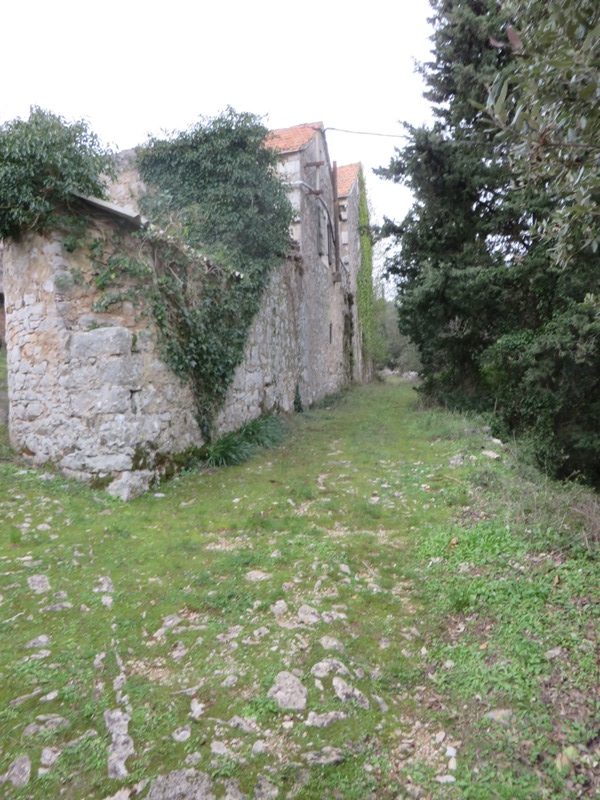
A chained dog barked as I walked past. She disappeared inside before I could wish her “Dobro jutro” and I suspected she was peering from behind thick lace curtains at me as I continued up the path.
The Maquis forest was quiet. A few birds calling, but no wind to rustle leaves and branches.
The wide limestone way is made from stones moved from the land on either side over the aeons. What were once productive fields are now abandoned to the Maquis, but evidenced by the Rosemary and Lavender plants by the field walls. The Rosemary has its steel blue flowers at this time of year and as you brush past, their scent is released onto your clothes.

This is no Roman road – of which we have several, arrow straight examples. This is a locally surveyed, practical route. The shortest possible distance between two ancient settlements, taking into account terrain and gradient.
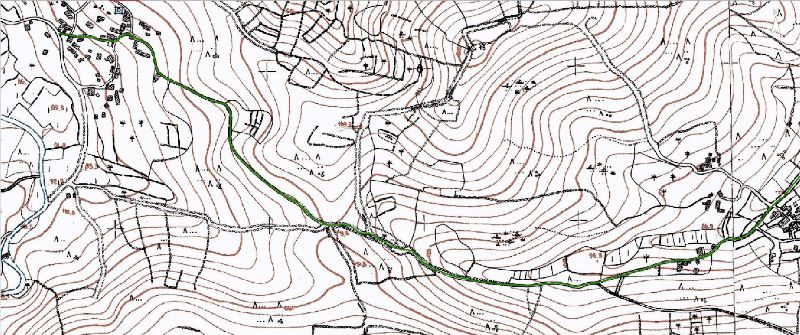
In the saddle where the track crosses between two hills and where the Parish Boundary lies, is a water cistern with an iron cover. I presume to refresh travellers.It is a 100 meter vertical clime from each village to the saddle, but over a distance of 950 metres, so overall a gradient of 10%. It does not feel steep when you walk it in winter.
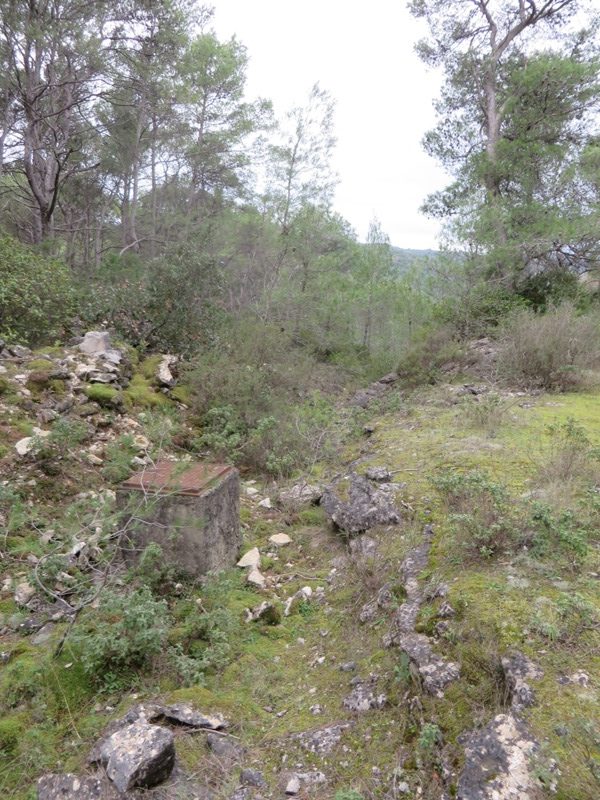
On a baking hot summer day, I might feel a little different though.
On the Dol side of the hill, the old road, which runs downhill in a straight line from here, before continuing on to the Parish Church is now impassable and overgrown. Only the map shows the route, the actual path veers off to the right, on a gentle downhill slope bringing the walker into Šurokovića Dvor.

When I walk these old paths, I usually carry a pair of secateurs. Along the route there are places where small shrubs, especially some of the natives with thorns, are encroaching. A few small snips cut them back and maintain a clear path.
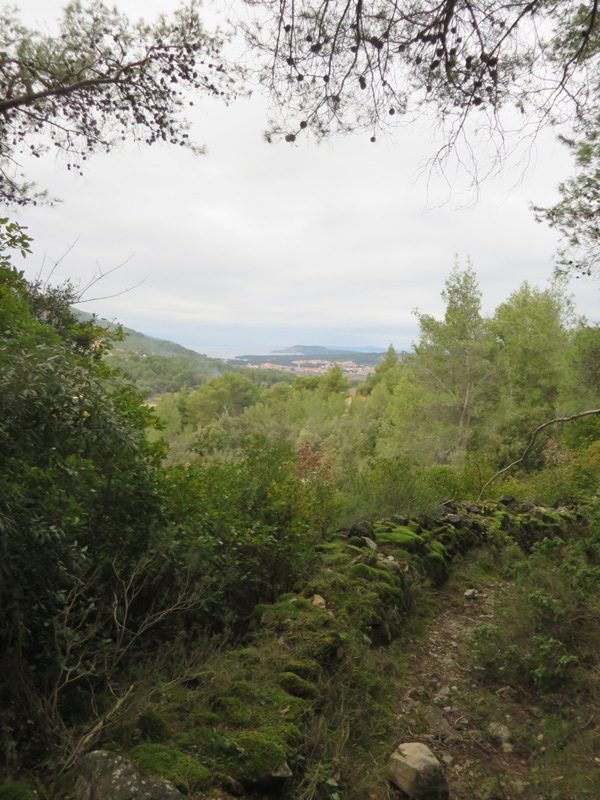
There are lovely views, even on a cloudy day. On a clear day the mainland is visible, which ever direction you are going in.
Clearly the path is still used, but probably not much in winter. What it did make me think about is some work I started a couple of years ago, mapping all the local footpaths, and the various states of repair they were in, so I can make the information available to visitors. Time to dust off that task I think…
Habitat Network – Citizen Science
On the internet, nothing is permanent.
The internet has to be paid for by someone somehow, whether through sponsorship advertising or the owning company.
This week I received an email from the Habitat Network to say that their grant expires at the end of January and they have been unable to secure additional funding, so the project will be mothballed.
This was a citizen science project that I joined in 2015 and using their mapping tools I created a plan for the orchards, which is pretty much where I am at now.
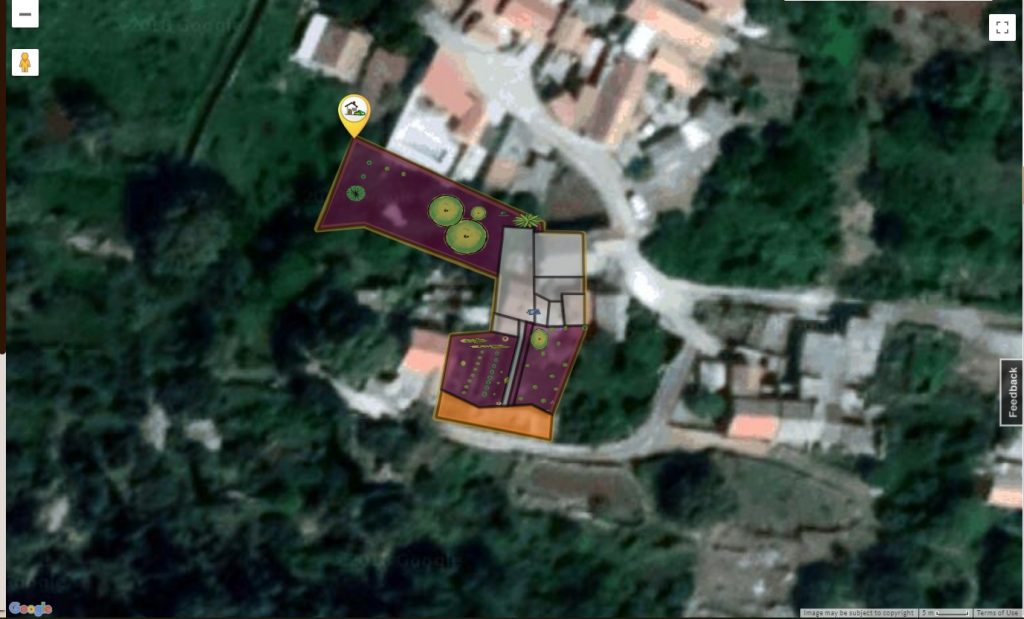
They had a lot of good ideas and guides for things like composting and irrigation, but whilst it is sad to see it go, there will be other equally useful sites.
Weeds again!
One blog podcast I follow is A Way to Garden on Robin Hood Radio and a week ago they were talking about a scientific study of solarisation – the best kind of cover to put over soil to kill annual weeds seeds.
If you had asked me,I would have said black plastic, because being dark it absorbs heat and prevents light, which is one of the cues seeds use to kick start the germination process. It turns out that clear polythene is a better material, because it allows light in, but the soil also heats more, so killing more of the seeds.
I continue to lay cardboard over ground to prevent weed growth, which works most of the time. Some perennials, like briars find their way between the cardboard sheets and being deep rooted, continue to grow. I feel an experiment coming on in the spring in the top orchard, which I need to tame.
Garden chores
Jobs around the garden this week have been to continue the weeding and removal of the winter weeds.
With recent rain, the soil is quite soft so it is easy to dig over with a bedding fork and then remove the weeds by hand. Everything goes onto the compost heap, so nothing is wasted.
I’m careful to disturb the soil as little as possible, so more seeds are not brought to the surface from the soil seed bank.
That reminds me that I need to build a new compost heap, near to the wood shed and garden stores in the top orchard.
I have burnt through most of the small pieces that I cut, back in the autumn.

So there is now room to move in logs which have been stored outside, but under plastic.

They have been cut into lengths of about a metre and I’ll keep them like that and let them dry thoroughly over the summer, then cut them to size before I need them at the end of this year. I have enough wood ready to use for this winter season, without having to break into this new supply.
One job I do need to do before I move them though, is to fix a support under the roof of the wood shed. I have found that because there is a join between the two lengths of two metre metal roofing, rain water is pooling in the centre and then overflows into the store.
I think I’ll just add it to the list of jobs for next week. NRC
3 Responses
Denis W
Ever busy Norm Happy New Year my friend
veu5ko1_admin
Always Den! Same to you…N
Alan W.
Looking good Norm Have a great New Year